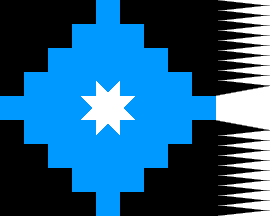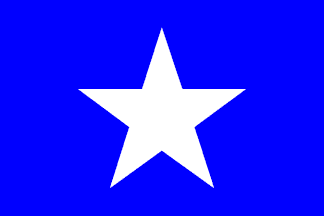
Last modified: 2006-05-27 by antonio martins
Keywords: mapuche | drum | kultrun | chakana | contest | star: 5 points (white on blue) | star: 8 points (white) | lautaro |
Links: FOTW homepage |
search |
disclaimer and copyright |
write us |
mirrors

In 1992, in the V Centenary of the discovery of America, the
Mapuche people adopted a national flag that was presented for the
first time to the Spanish king in his visit to Chile. The flag is
based on the Nagche regional flag, but
is quite different in the border, the stripes (only three) and the
central emblem.
Jaume Ollé, 08 Nov 1996
In the spring of 1991 in Valdivia was celebrated a convention called Meli Witram Mapu of the Mapuche People. The adoption of a national flag was aborted and 500 projects were presented. Five projects were selectioned for the five regions of the Mapuches. The definitive national flag was approved in 1992. The Mapuche unified their traditional government in 1991 in the National Conference of Temuco (18-21 March). The Aukin Wallmapu Ngulam (Council of all the lands) dirige currently the Mapuche People.
The flags share a common symbolism:
Jaume Ollé, 16 Sep 1996
The central device (drum, in
mpauche language Kultrun) of the flag.
Jaume Ollé, 09 Jul 2004
There are a lot of details variations from one Mapuche
flag to another. For example the exact wide of the
stripes and the kultrun, or the exact colors.
Francisco Gregoric, 16 Jul 2004
The Mapuche “national” flag has a star on
the lower fly and crescent on the upper hoist, and a “starfish”
sun on the other two quadrants. Other Mapuche flags show the kultrun
with a “starfish” sun on all quadrants.
António Martins, 06 Jul 2004
This flag, with very minor differences, is listed under
number 201 at the chart Flags of Aspirant Peoples
[eba94] as: «Mapu [Araucania] (Mapuche
Indians) - Chile.».
Ivan Sache, 15 Sep 1999
The Santiago
Indymedia website shows a lot of Mapuche flags in a demonstration in
Santiago, Chile. The blue stripe seems to vary from medium to light blue, with
no meaning in that variation.
António Martins, 30 Jan 2006
The newspaper today has a picture (can’t find it online) of a
Mapuche protest in Chile. Flying is a Mapuche main flag,
but with the border (the shapes looking more like diamonds, but that may be
the picture) covered three (if not four; can’t see) sides, and no
emblem on the stripes (possibly two, maybe three). It’s somewhat
like the Nagche flag, but with no emblem and
possibly less stripes.
Nathan Lamm, 11 Aug 2004
The white designs inside the black stripes are geometric and straight
in all the Mapuche flags I have seen.
Francisco Gregoric, 16 Jul 2004

This is the flag of Qullasuyu, one of the Inca
“quarters”, the one including Chile.
António Martins, 17 Jul 2004
Mapuche do use the square rainbow Whipala flag as a kind of
“symbol of Native peoples from South America”. The whipala
flag is a symbol associated with the Inca Empire.
However in ancient times, groups as Mapuches did not accept been part of
empires as the Inca Empire. The Mapuche could keep their independence of the
Inca Empire.
Francisco Gregoric, 16 Jul 2004

At Millamap webpage,
there is this comment: «According to Mr. Cesar Famin, in his Historia
de Chile 1839, the Mapuche flag is made of a white star on a blue
field.»
Olivier Touzeau, 09 Oct 2002
White star is small and was generally six pointed (even eight
pointed, always in XVI-XVII centuries) until XIX century when
five pointed star came on use.
The blue was always light. Theres a suposed flag from Lautaro, the
heroic aracaunian leader that fight against spanish invaders, that
is light blue with a white central device as several small quares
one at side of other in diagonal; this was used in Valdivia Battle
and I have only a reconstruction. In a spanish picture show Lautaro
with a flag as the above.
Jaume Ollé, 09 Jul 2004
The main motive, in blue, is very similar to the chakana, an
Inca symbol, here depicted simply as a
figure enclosed in a crude zigzag line, made from isometric segments
(stacked square blocks 1+3+5+3+1).
António Martins, 16 Jul 2004

At Millamap webpage,
is shown flag said to be a Mapuche flag, and which looks like a
Bonnie Blue flag or a
Somalian one… There is this comment:
«According to Mr. Cesar Famin, in his Historia de Chile 1839,
the Mapuche flag is made of a white star on a blue
field.»
Olivier Touzeau, 09 Oct 2002
In XIX century five pointed star came on use for imitation to foreigners
(the Chileans).
Jaume Ollé, 09 Jul 2004
Anything below this line was not added by the editor of this page.